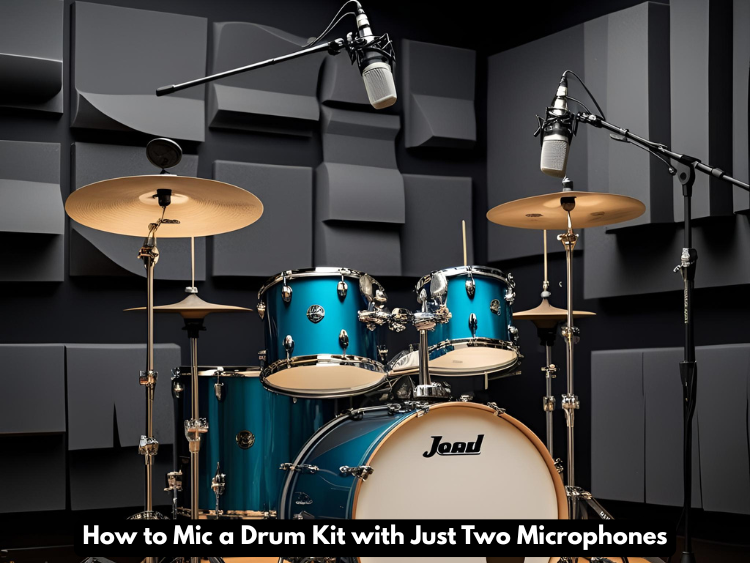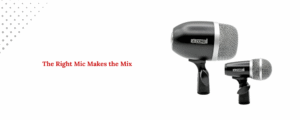It may appear difficult to record drums when you do not have many mics or a fancy studio. However, there is some good news: one can make a great sound of drums using just two microphones. Excellent! That’s it! It is one of the most excellent low-cost/budget/home recording setups. In this article, we are going to discuss various options for setup, why two mics are this effective, and how we can get the most out of our drum kit.
How Two Mics Can Capture a Full Drum Sound
The two-mic method has been used on some great records, so it’s not just for beginners or cheap sets. It is often used by engineers to get a natural, open sound that brings out the best in the drummer’s performance without adding too much processing.
Here are some good things about it:
- Less gear: Less setup and fewer cords mean it’s easier.
- Phase Coherence: Phase problems are less likely to happen when you have fewer microphones.
- Musicality: With two mics, you have to pay attention to setting the drums, placing the mics, and playing.
Tune Your Drums Before You Turn on the Mic
Make sure that your kit sounds good before you even connect a mic. Mic placement and choice are important, but they can’t fix a drum that isn’t set right. Clean up the sound of your drums by adjusting any rattles and tuning the heads. Having a good-sounding kit in the room will help you do your job a lot.
How to Pick the Best Mics
You will need to have two condenser mics; one of them should have a small diaphragm, and the other one should have a big diaphragm. The condenser type of mic is perfect since it records a broad frequency spectrum and also has excellent sensitivity when using just two mics. But in case you only have the dynamic mics, then no need to be scared: good sound can be obtained as well. You may not have nearly the high frequency ,but you will have good sound.
Here are some great microphones to think about:
- AKG C214 or C414
- 5Core Drum Mic
- Shure SM57
- AT2020 or AT4040 from Audio-Technica
Are you looking for a drum mic for your studio room? See more great drum mic kits for home studios.
Setting 1: The Glyn Johns Method
This magic trick acquired the name of the engineer Glyn Johns, who has used this magic trick to record some artists such as The Rolling Stones and Led Zeppelin.
Setup:
- Overhead Mic 1 – Position one mic 3-4 feet over the snare, and it must be pointed downwards. This depicts the entire kit, though the snare and the toms are prominent.
- Overhead Mic 2 – Put the second mic to the right of the drummer, a few inches above the floor tom and slightly behind it. It should face across the kit toward the snare.
To keep the phase straight, make sure that both mics are the same distance from the snare. If you need to, use a tape measure.
To get a good audio spread, move the mics to the left and right in your mix.
Result: The Glyn Johns method gives you a strong, wide picture of how to hit with the snare and kick.
Setting 2: Overheads That Are Spaced Apart
This set-up lets you hear more of the room and the cymbals.
Setting up:
- Overhead Left – Put one mic about three feet above the hi-hat and drum side, pointing slightly down.
- Overhead Right – Put the other mic on top of the floor tom/ride side of the kit.
Again, try to keep both mics about the same distance from the snare or kick to avoid phase issues.
Note: More cymbal shine and a “wider” picture are available with this setup, but it can be harder to use in small or poorly treated rooms.
Setting 3: Overhead and Kick
In rock or pop music, this might be your best bet if you want more power over your low end.
Setup:
- Overhead – Place an overhead condenser mic 3 to 4 feet above the drum kit and place it over the snare.
- Kick Mic – Put a dynamic mic, like an AKG D112 or a Shure Beta 52, just outside the heavy head of the kick drum.
Tips:
- Blend the top to get a better picture of the whole kit, and use the kick mic to add punch to the low end.
- EQ and compress the kick to make it fit your style.
Last Words
It’s all about placement, balance, and recording ability when you use two mics on a drum kit.
No need for a dozen mics or a degree in audio engineering to get a full, natural drum sound. Just use the right method and try different things.
It doesn’t matter if you use the Glyn Johns method, spaced overheads, or an overhead-plus-kick mix. The point is to serve the song. Pay attention to getting a clean performance.




